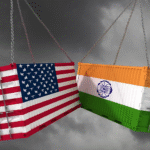Executive Overview
In a world struggling with new problems-climate risks and digital inequality among them-mega-infrastructure projects are central to both national survival as well as international clout. The infrastructure dreams of India are becoming more ambitious, but how do they actually stack up against schemes elsewhere? The article examines the whirl of mega-projects crisscrossing continents, in the form of ports, high-speed rail, renewable energy grids, smart cities, digital highways and evaluates the Indian development against global precedents. It highlights practical suggestions, strategic gaps, and pioneer spirit which may make India not only play catch up, but to be a leader.
1. Why Mega-Infrastructure Matters in Today’s World

1.1 Scale and Strategic Impact
It seems that we are in an era of mega‐infrastructure, with huge ports, integrated high‐speed rail networks, megawatt‐sized renewable energy parks, and even city-sized smart systems all influencing economy, geopolitics, and climate resilience. They promote neighbourhood, city livability, economic ripple effects as well as international reputation.
1.2 Global Drivers
The need to invest at scale forces nations to respond to rapid urbanization, weakened supply chains, climate crisis, digital transformation, and geopolitical competition. In developed economies infrastructure is used to maximize output, emerging economies are more focused on access and growth whereas middle powers such as India have to balance inclusion and efficiency.
1.3 India’s Unique Context
Having more than 1.4 billion population, India is a country that has the problem of infrastructure deficit, rural-urban inequality, and environmental vulnerability. Strategically located between immediate impact and long term sustainability, India is putting its eggs in every basket, whether metros, or mega‐power corridors, digital highways, or green energy clusters. It is critical to understand what India needs in the progress of the world.
2. Global Case Studies: Benchmarking Mega‐Projects
Let’s examine emblematic global mega‐infrastructure projects—size, ambition, rationale, and lessons.

2.1 Ports and Logistics: Expansion and Efficiency
- Panama Canal Expansion (Completed 2016): Expanders admitted Post-Panamax vessels, increasing trade. Logistic and strategic finesse.
- Jebel Ali Port (UAE): The biggest artificial harbor in the world; well automated and high-depth capacity.
- Port of Hamburg (Germany) and Port of Rotterdam (Netherlands): Rail, River, Hinterland, and Green Operation integration.
India takeaway: Doesn’t simply require larger ports but better, more multimodal port operations using the railroad, road, automation, and sustainability.
2.2 High-Speed Rail and Transit Networks
- China High‐Speed Rail (HSR): The United States has the longest high‐speed railway system in the world, the Republic of China has a network of more than 42,000 km by 2025, electrified, very dense, well‐connected with urban networks.
- Japan, Shinkansen: Introduced lifetime reliability, punctuality and safety.
- Europe: The TGV / ICE of Europe: Intercontinental lines with overlaps of metros in France and Germany.
Indian Projects: The first Mumbai-Ahmedabad HSR (MAHSR) project is being built, with Japanese assistance, and estimated to operate at speeds up to 320 km/h. Additional steps toward the same direction are the Sagarmala port-rail network and Dedicated Freight Corridors (DFCs). Reforms of land acquisition, cost control and institutional capacity are an essential requirement of success.
2.3 Renewable Energy Mega‐Grids
- China Wind-Solar Mega‐Base: Hunt Gigawatts of wind and solar in great regions, interconnected with cities in many provinces.
- European Super-Grids: Interconnectors between Spain, France, Germany and Nordic countries can balance variable renewables.
- UAE Mohammed bin Rashid Al Maktoum Solar Park: Multigigawatt phasing, CSP, and PV.
India’s Initiatives:
- RUMSL (Rewa Ultra Mega Solar Ltd.): Early X-scale: successful.
- Visionary Green Energy Corridor (GEC)- greens-to-grid connections.
- Future aspirations: 500 GW renewable energy capacity by 2030, a national hydrogen mission and west coast wind corridors. The transition depends on the modernization of grid and feasibility in terms of finance
2.4 Smart Cities and Urban Mega‐Clusters
- Masdar City (UAE): Energy-saving, planned city running on renewables.
- Songdo (South Korea): IoT-rich env. containing sensors.
- Xiongan New Area in China: Gray city and mega-scale urban design with smart governance convergence in XR.
Indian Effort: Smart Cities Mission (100 cities) Smart Cities Mission compliance with an emphasis on digital infrastructure, e-governance, and transportation, municipal services, and resilience. Some cities will succeed more than others, increasing the power of local governments and models of partnerships with the business community will be essential.
2.5 Digital Infrastructure: Undersea Cables to Nation-Wide Networks
- Transatlantic submarine cable companies: ACC Delphi, FLAG, SEA-ME-WE, MAREA handle intercontinental traffic.
- High capacity backbones: The accumulated backbone structure in Europe and North America are high density fibres in the form of fiber grids.
- Singapore smart nation digital fabric: Fast, all-inclusive digital services.
India’s Landscape:
- BharatNet: massive program to connect millions of villages through OFC. Not much is going right–but growing market demand for telecommunication is driving a renewed pace.
- 5G development, proposed India-Middle East-Europe (IMEWE) subsea cable, fiber extensions, terrestrial.
3. India in the Global League: A Comparative Analysis

3.1 Scale & Scope
International ambition is apparent in the mega-projects of India, including HSR, Smart Cities and Renewable Corridors, although the mega-projects are executed in a segmented manner. By comparison, the efforts in India are increasing hesitatingly, when compared to the nationwide integrated HSR in China.
3.2 Implementation Structure
Mega-projects around the world enjoy the use of central planning, specialized financing, reform of institutions, and cross-sector integration. To emulate such models, India needs to coordinate federal, state, and privately involved actors better.
3.3 Sustainability & Resilience
Whereas the climate resilience in many global projects has been well enshrined, those in India are gradually doing so, but they require more improved standards, execution, and vision especially in flood-prone or climate-susceptible areas.
3.4 Technology & Innovation
Advanced automation, AI, digital twins, and sensor networks are common in Western and east Asian mega-projects. India was an example of the push toward digitalization, which encompassed not only some physical infrastructure; e.g., UPI in the banking sphere-but also includes incidences of such sophistication.
3.5 Financing & Commercial Viability
China employs huge state capital and state owned bank loans. The European models are a combination of the public-private frameworks (PPP). To maintain momentum India must be innovative in its financing (e.g. infrastructure investment trusts, blended financing, green bonds).
4. Sector-by-Sector Deep Dive: India vs Global Contenders

4.1 Ports & Logistics
- Global bar: Deep water port + hinterland integration + electronic layers logistics (e-customs, cargo tracking).
- India: Sagarmala seeks transformation; the Dharamtar Port, Vadhavan Freeport, and JNWNH Tidal Port (Andhra Pradesh) are successful, along with the success of the JNWNH tug-barge shipyard at Machilipatnam (Andhra Pradesh)? However, there are still unresolved issues of coordination, land acquisition, lack of skilled labour and rail/road connectivity.
4.2 High‐Speed and Freight Rail
- Entering the world stage: Technology base of China, European networking.
- India: HSR is experimenting at MAHSR. Western and Eastern Dedicated Freight Corridors are under development in half. The positives are that some of their more innovative uses (e.g. solar deployment along tracks, double stacked container capability) are promising.
4.3 Renewable Energy Grids
- Global bar: Gansu’s mega-base, cross-border supergrids, hybrid solar‐CSP plants.
- India: Winning solar auctions, Wind mapping, green Hydrogen pilots GEC link. But grid constraints, transmission constraints, and discom financial worries stymie it from!
4.4 Smart Cities & Urban Plans
- Global bar: Low energy, data-driven managed tech-based city ecosystem.
- India: Bright City schemes have been innovative (e.g. Jaipur Smart City: Intelligent Traffic Control), but destructively prone to governance bottlenecks on IGC/incorporation and agent testimonial adoption.
4.5 Digital Connectivity
- Global bar: Everywhere access to high speeds, digital fairness, IoT-ready services, networks.
- India: BharatNet linking far panchayats; 5G deployment is in progress; increasing submarine cable projects. Adoption and affordability, cybersecurity and rural digital literacy problems persist.
5. Strategic Paths Forward for India
The following are progressive, feasible, policy and implementation recommendations based on international best practice:
5.1 Centralized Seeing, Decentralized Doing
Instead, India requires long-term national visions (e.g. 30 year infra plan), but implementation at state-level with flexibility to allow execution subject to performance metrics and accountability.
5.2 Integration of Multi-Modes
Make sure that there is connectivity between the ports and the rail/road corridors and even industrial clusters (i.e. port-rail logistics parks) that minimize bottleneck and resulting transaction costs.
5.3 Institutional Innovation
Introduce project-autonomous, professionally operated special purpose vehicles (SPVs) or, as examples in China (railways bureaus), or the United Arab Emirates (port authorities).
5.4.Smart Financing
Infrastructure investment trusts (InvITs), green bonds, blended finance involving development finance institutions, and tariff reforms must be used to maintain the commercial viability of the infrastructure.
5.5 Digital and data-driven infrastructure
Mandate intelligent, sensor monitoring on highways (to diagnose maintenance needs), power grids (to balance load), ports (to track goods) and cities (to control water and waste management).
5.6 incorporation of sustainability
Implement climate sensitive site location, green standards, flood resiliency, heat adaptation, and biodiversity at the planning level. Key inputs: solar, wind, hydrogen.
5.7 Design‐Oriented to People
Incorporate communities early in developing to minimize conflict- make sure that projects increase living standards in the region, introduce accommodative services and social equity in the region.
5.8 Working Globally
Broaden collaborations (such as Japan on HSR, EU on smart cities, multilateral organizations on green finance) to get access to best technologies and co-funding.
6. India’s Success Stories: Seeds of Transformation
- Rewa Solar Park: Decimated the solar tariffs; pioneered new power-purchase concepts.
- Dedicated Freight Corridors: When fully implemented, this may reduce freight transit times, greenhouse gas emissions and enhance manufacturing hubs.
- UPI & IndiaStack (Digital Payments): A breakthrough in digital infrastructure; demonstrates that India also knows how to construct digital mega-systems at scale.
- DelhiMeerut Metro Extended Network: Improved last-mile connections, advanced fare collection systems and energy efficiency systems.
- These facts bear out: where strategy, technology, and institutions come together, exceptionally powerful outcomes may be the outcome.
7. Looking Ahead: The Next Decade in Review
As the tensions around climate, trade and urbanization continue to grow, the coming decade will determine who makes the key advances. For India:
- In 10 years, India should provide climate-neutral harbours, active HSR routes, 500 GW of renewable grid, complete smart-city networks, and broadband in all locations.
- It will have to be administered with daring vision, institutional capacity-building, financial innovation, and transformation digitally.
- The world is waiting: India can compete on an equal basis with infrastructure super-powers- not just playing catch-up, but dictating future standards of inclusivity, sustainability, and digital resonance.
India is neither backward nor forward, rather she is very much in dire poise. Countries such as China, EU, Japan, Korea and the Gulf states have been storming ahead with large scale integrated and well financed mega projects. Nonetheless, India has the power of exceptional demographics, digital policing (e.g., UPI, Aadhaar), green potential, and young flight towards a remarkable runway.
Pakistan dynamically integrating finance, governance, technology, and sustainability, with urgency and imagination, can establish fresh international standards, and it will innovate inclusive mega-infrastructure that will map the 21st-century terrain. It is an enormous undertaking, and an enormous opportunity. The way forward, in the case of India, is to leapfrog, learn on a global scale, to act locally and scale the impact at a national level.










